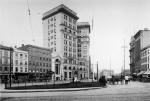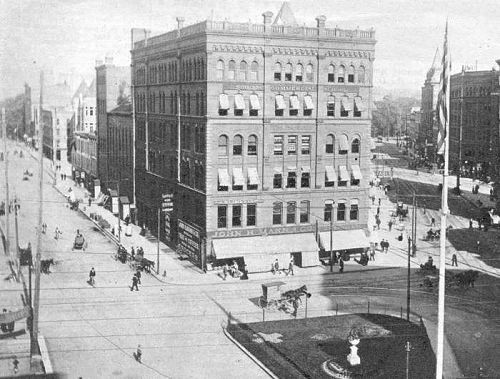|
Hanover Square |
|
|
|
|
|
In the 1820's, a consortium of shops called the Hanover Arcade was located where the State Tower building now stands. The "Hanover" name has endured to this day, although the square was sometimes also called "Hangover Square" because of the many taverns that once surrounded it. The triangular shape of the square was formed in the early 19th century when the city's new grid street system was superimposed on the diagonal route of the early Genesee Turnpike (today Genesee Street). The larger Clinton Square, just to the west, had developed first but, following completion of the Erie Canal in 1825, commercial and retail activity quickly spread along Genesee Street into Hanover Square. All of the East Water Street buildings, on the north side of Hanover Square, had their backs to the canal. The utilitarian northern side of these buildings facilitated the movement of goods on and off the canal boats. At the front, the buildings presented a more ornate face to potential customers and the city in general. From about 1840 on, another transportation link just one block to the south -- the railroad -- brought additional commerce to the Square. The first buildings on the square were a church and several wooden structures, both commercial and residential. In March of 1834 a devastating fire destroyed all the buildings on the north side of the square, next to the canal. These were replaced that same year by a row of narrow brick structures, in the Federal style, with high gable ends and roofs pitched toward the street. Because they rose so quickly on the site of the burned structures they came to be known as the Phoenix Buildings. Four of the Phoenix Buildings still stand on the northern edge of the square today.
Owners of the wooden buildings across the square to the south, envious of the newly erected brick structures, agreed in 1834 to erect a similar row of brick buildings along East Genesee. Franklin Square was known at that time as Franklin Square and this second row of brick buildings was named the Franklin Buildings. Three of the Franklin Buildings still stand on the southern edge of the square today. During the early days of Syracuse, because Hanover Square was the major transfer point on the Canal, it became not only the city's primary commercial district but also its primary meeting place. As with Clinton Square, this natural public space has been an important center of social and political life, with its public meetings, demonstrations and partisan speeches. During the Civil War, military recruiting booths covered the Square. In 1865, when Abraham Lincoln's remains were traveling through Syracuse on their way to internment in Springfield Illinois, thousands came to Hanover Square to hear eulogies for the fallen leader. Most of the buildings that constitute the boundary of Hanover Square are very much as they were before World War II -- in fact, much of Hanover Square is little changed since the Civil War. Several of the buildings date to the period of the 1830's, 1840's and 1850's. Other buildings on the Square date to the late 19th century. Hanover Square is a laboratory of architectural styles. Federal, Greek Revival, Second Empire, Italianate, Romanesque, Sullivanesque, Victorian Gothic, Queen Anne, Neo-classical and Art Deco are all represented. Seventeen buildings in all, grouped triangularly around this historic open space, are listed on the National Register of Historic Places. Historically, Hanover Square has been almost exclusively commercial. Aside from the shops and businesses located here, it served as a "hack stand" where drivers would hire out their wagons to local merchants. For years pedestrians, especially ladies, complained that they could not safely travel from one side of the Square to the other due to the standing carts, mud and moving vehicles. Because Hanover Square was so compact, and the lots so small, it was not easily incorporated into the large urban renewal projects that leveled whole city blocks just a few yards away. Hanover Square was the city's first Historic Preservation District. |




